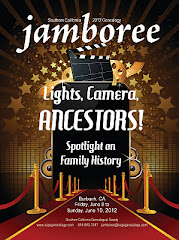I am exhausted after 4 days of the Southern California Genealogical Society Jamboree. But in some cases being exhausted is a good thing. And in this case it definitely is.
If you haven't been to Jamboree you may want to consider going. This conference is one of the best. I am a big believer in ongoing genealogical education and Jamboree delivers.
What's to like about Jamboree? Well here's my Top 10:
10.
Prizes, Prizes, Prizes! Jamboree provides so much to participants. $17,000 of prizes were given out and that's not counting the drawing exhibitors did at their booths. Attendees who strolled the Exhibit Hall towards the end of the conference were awarded with last minute sales and deals from the vendors.
9.
Audio Recording. Even if you weren't able to go, many of the sessions were audio taped. You can order these recordings from
Conference Resource. They save these recordings as audio files and you can even order a USB drive with the audio files of the entire conference. There's nothing like getting audio files from a conference and listening to them over and over to help you enhance and expand your research skills.
8.
Networking. Networking is so easy at a conference. It's a time to introduce yourself to others, ask questions, find cousins and more. With opportunities between classes, the Surname Wall and the Exhibit Hall you have no excuse not to get the information you are seeking.
7.
Location. Now the location isn't perfect but guess what, no location is. There will always be conferences that are too far, too small, too cold or too hot. What's nice about Jamboree is that it's in the same place each year making planning easy. It's literally across the street from the airport and down the street from the train station. You can come by plane and walk across the street if you wanted. Restaurants, a grocery store, the post office and an electronics store (in case of technology failure) are all within walking distance.
6.
Streaming Sessions. Can't go to Jamboree? Well there's always the streaming sessions. My friend who lives in Virginia attended Jamboree via these sessions, complete with handouts. The good folks at Jamboree do a great job of partnering with sponsors to make sure Jamboree is accessible to as many family historians as possible.
5.
The App. Yes, there is an app for everything nowadays and Jamboree is on the forefront of that. Jamboree had an app last year and this year. That app provided schedules, handouts, maps and even a way to plan out your own schedule. A great tool that should be used by all those who attend and even those who can't.
4.
Research Assistance. Members of the
Southern California Chapter of the Association of Professional Genealogists (SCCAPG) provided Jamboree participants with one-on-one help with their genealogical brick walls. Did I mention that this was professional genealogical help for
Free? Participants were able to sign-up prior to Jamboree to ensure their spot on the schedule. Make sure you take advantage of this next year, this is a wonderful benefit of Jamboree. (Yes, I am Vice-President of SCCAPG but I was not a part of this effort).
3.
The Exhibit Hall. Like all conferences, the Exhibit Hall is important. Now, I'm not saying that because I was working in the booth for the
National Institute for Genealogical Studies. I'm saying that because it provides attendees and the general public (the Exhibit Hall is free) to talk with companies, solve problems, seek assistance and learn. It should be the place for you to seek out help from the companies whose products you use and to learn about services you might want to begin using. There are also mini-presentations given by some of the vendors. Jamboree had a lot of great vendors from subscription websites (
GenealogyBank,
Find My Past,
Ancestry) to social networking websites (
WikiTree) to Societies (
Sons of Norway,
SCCAPG,
CGS,
CSGA and many others) to those who will help you edit your family history book and date your vintage photos (
Stories to Tell,
PhotoTree) and authors (
Ron Arons,
Lisa Louise Cooke,
Denise Levenick). Now, these aren't all the vendors it's just a sprinkling of those that attended.
2.
California. Why should you come to California for a genealogy conference? Jamboree is conveniently located to many great research facilities like the
Los Angeles Public Library and of course the
Southern California Genealogical Society Library. The
Immigrant Genealogical Society Library is also down the street. Within 2-3 hours of beautiful downtown Burbank is the
Carlsbad Library and the
National Archives.
1.
The Presenters. All I can say is WOW! There was such a great mix of presenters at Jamboree. Starting with Steve Luxenberg who while not a "genealogist" wrote one of the best books using genealogical research,
Annie's Ghosts. If you have not read this book, you should. The list goes on and on of who was there including
Megan Smolenyak,
George Morgan,
Drew Smith,
Jana Sloan Broglin,
Tom Kemp,
Steve Morse,
Maureen Taylor and so many others. This is your chance to listen to the greatest in the genealogical world.
Now's the time to start planning to attend this event. You'll be glad you did. To learn more about Jamboree, check their
blog and
website.
The not so small print: Now in case you are wondering, yes, I was a speaker at Jamboree. Yes, I
was audio and video recorded and yes, I did receive some compensation for speaking just as I do for any speaking engagement I do. I have been
attending Jamboree long before I was a speaker there and believe in this
conference whether I speak there or not. No one asked me to write this nor paid me to.
I only blog in things I believe in.



